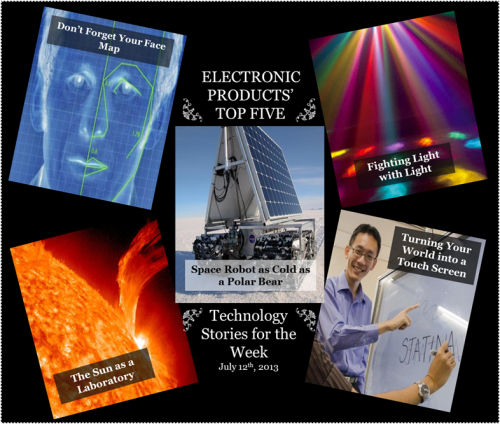Imagine showing your face as an instant digital recognition tool or sending from your kitchen table (we literally mean from your wooden kitchen table). The world is changing before our eyes, but here are your top five jaw-dropping technology stories from this week. Learn about a robot that can withstand nasty Greenland weather and trapping light with light and more!

Turning the World into Into Your Touchs Screen
New invention transforms objects into touchs screens
We’re used to tapping away on our smartphone screen, but what about our kitchen table? Nantyang Technological University researchers have created STATINA, the Speech Touch and Acoustic Tangible Interfaces for Next-generation Applications. The low-cost invention allows for the various television screens to be hooked up to a computer and it’s automatically able to track fingerprints. Almost any surface can be made into a STATINA touch screen — , like windows, walls, wood, and steel, and more. The low-cost invention allows for the various television screens to be hooked up to a computer and it’s automatically able to track fingerprints. STATINA uses vibration sensors and a unique algorithm to find exactly where the fingerprint is. Looking forward, the STATINA team is looking to make their its product commercial for all to use.
Space Robots as Cold as a Polar Bear
NASA’s new robot is first to pass polar test
What better way to test the durability of a new space robot that to place it in one of earth’s Earth’s most intense environments. A team of scientists took the GROVER (aAbbreviated for Greenland Rover or Goddard Remotely Operated Vehicle for Exploration and Research) robot to Greenland and watched its success against 30-mph MPH winds and temperatures as low as -22⁰F. GROVER is made to use radar to analyze layers of snow and ice. GROVER was also tested on Maryland beaches and in Idaho snow. GROVER will work with battery- powered solar panels and with give live updates with on how the its internal systems are working.
Fighting Light with With Light
Innovatively trapping light
Usually an easy way to trap light beams is to use mirrors, reflective surfaces, and sometimes photonic crystals. But the process is changing: as Aa group of MIT researchers teamed up and discovered a new method to trap beams of light. This system simply puts light waves against other light waves that have the same wavelength but different phases. This means that the two waves cancel each other out. The team suggests that this theory could possibly work on sound waves and radio waves as well. MIT Professor Marin Soljačić working on the projects statessays that this method is important for the making of lasers, solar cells, fiber optics, and other optical devices.
Don’t Forget Your Face Map
Digital face recognition to help against imposters
Say goodbye to the fingerprints, eye recognition, and finger swipe. Face recognition is on the horizon for biometrics measuring the blood vessels under the skin with thermal imaging. Every person has a different map of the blood vessels in the face. Fingerprints and the lens of the eye have been successfully altered, Altered contact lenses and rubber replications of ones fingerprint have been used in spoofs but blood vessel maps cannot be changed. Security systems would be programmed with an infra-red scanning device to scan a person’s face, making it nearly impossible for an imposter to pose as someone else.
The Sun as a Laboratory
Antimatter found in solar flares
Microwave and magnetic-field data haves recently detected that solar flares are home to antimatter. A small team of professors and researchers from NJIT presented this discovery at the 44th Meeting of the American Astronomical Society’s Solar Division. The team discovered the presence of positrons, relativistic antiparticles, using solar-dedicated facilities in outer space. This clears the constant confusion about asymmetry between matter and anti-matter. The team wanted to gather data on the issue on the largest scale possible, by using the Sun as their workshop. The results will assist in the understanding of other astrophysical objects using other radio-telescope observations.
Advertisement
Learn more about Electronic Products Magazine





